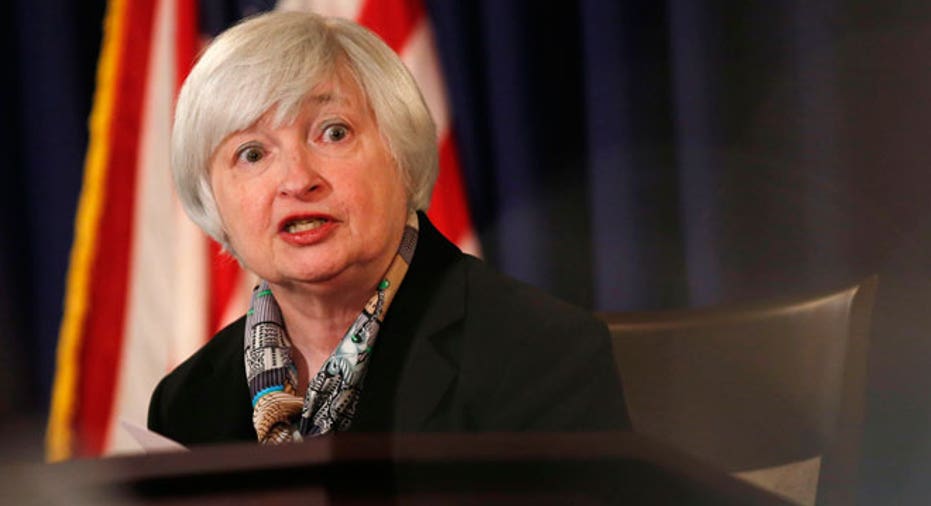Fed Won't Be Coy About Telegraphing Rate Hike

When the Federal Reserve finally gets around to raising interest rates from the near-zero range where they’ve been held for nearly six years it shouldn’t come as a surprise to professional traders, mom and pop investors and other market participants.
The Federal Open Markets Committee (FOMC), which sets most Fed policy, is expected to clearly telegraph the move months in advance, possibly starting with this week’s FOMC meeting which begins Tuesday and wraps up Wednesday. Fed Chair Janet Yellen will hold a press conference at 2:30 p.m. ET Wednesday following the release of the FOMC’s latest policy statement.
The Fed is widely expected to keep rates at their current range of 0%-0.25% and to continue scaling back its bond purchase program known as quantitative easing by another $10 billion per month. The Fed has said it will phase out its asset purchasing program altogether in October if the economy continues to show improvements.
So with quantitative easing rapidly drawing to a close all eyes are on interest rates. Specifically, the timing and trajectory of interest rate hikes that most expect sometime in mid-2015.
One thing everyone agrees on is that when rates do more higher, they will do so gradually.
“The recovery in the labor market is undeniable, but the combination of lingering concerns about the durability of that improvement and the absence of inflationary pressures will likely lead to a gradual restoration of more normal monetary policy,” said G. Scott Clemons, chief investment strategist at Brown Brothers Harriman.
Fed Won’t Be Coy
In order to prepare markets for the inevitable rate hikes, the Fed needs to alter the language of its monthly policy statements to alert market participants that the increases are forthcoming and that it will soon be more costly to borrow money.
It will be a significant shift away from the easy-money policies initiated by the Fed in the wake of the 2008 financial crisis in order to pump life into the economy and avert a full-on depression. Low interest rates have helped small businesses expand and consumers get loans to buy homes and cars. When rates go higher it could dampen that economic activity. Consequently, analysts are predicting that the Fed won’t be coy when it starts to shift its language away from the tone of patience that has held sway over Fed statements for several years.
One method analysts have suggested the Fed might use to better prepare markets for the eventuality of higher rates it to eliminate language that has been included in each of the Fed’s recent policy statements. Those statements have all said the Fed intends to keep rates low for “a considerable period” after it winds down its bond purchasing program.
That phrase -- “a considerable period” -- has calmed investors and other market participants who want rates to stay low because they fear higher borrowing costs could cut into corporate profits and put a crimp in the ongoing stock market rally. But economists believe the Fed is getting ready to lift the phrase from their statement.
“The Fed is inching towards a gradual exit from accommodative monetary policy that is expected to begin next summer with an initial interest rate hike,” wrote analysts at IHS Global Insight. “To get the ball rolling, the committee will soon adjust its forward rate guidance, which currently states that ‘it likely will be appropriate to maintain the current target range for the federal funds rate for a considerable time after the asset purchase ends.’ It is the ‘considerable time’ part that will be dropped to signal that rate hikes are close.”
Weak August Jobs Report Could Delay Shift in Language
Some analysts had predicted that the change in language could occur at this week’s FOMC meeting. But the IHS economists believe the Fed will probably use the weak August jobs report to justify holding off on the shift in language until later in the year.
Yellen has said labor market data will be a key indicator used to determine when rates will go higher. For months that data had been improving, with a run earlier this year of five consecutive months of more than 200,000 new jobs created as the unemployment rate continued to fall.
But the August report disappointed by reporting that just 142,000 new jobs were created last month. That seems to have caused a bit of whiplash at the Fed, where influential doves like Yellen had apparently been contemplating raising rates sooner rather than later based on the streak of positive jobs data but are now reconsidering.
Fed doves led by Yellen and new Vice Chair Stanley Fischer have repeatedly pointed to stubborn slack in labor markets as evidence that the economy isn’t ready for higher rates. Meanwhile, Fed ‘hawks’ such as Kansas City Fed President Esther George and Philadelphia Fed President Charles Plosser have made strong public arguments in favor of raising rates sooner -- possibly in the first quarter of 2015 -- as a deterrent to asset bubbles and runaway inflation.
Meanwhile, central bank policy makers appear to generally agree on the technical strategies for actually raising interest rates when the time comes and unwinding the Fed’s bloated balance sheet.
The approach, outlined in the minutes the Fed’s two most recent meetings as well as in officials’ public statements since then, keeps the focus on the federal funds rate, the rate banks charge each other for overnight loans, as the barometer for rates that will affect everything from mortgages to car loans.
Fed officials have said in various interviews that central bank policy makers would likely reach a final agreement on their exit strategy at this week’s meeting while leaving the rate liftoff timing open.